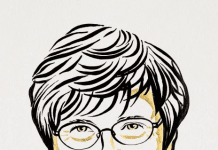A NEW study bolsters the idea that strange grooves crisscrossing the surface of the Martian moon Phobos were made by rolling boulders blasted free from an ancient asteroid impact.
The research, published in Planetary and Space Science, uses computer models to simulate the movement of debris from Stickney crater, a huge gash on one end of Phobos’ oblong body. The models show that boulders rolling across the surface in the aftermath of the Stickney impact could have created the puzzling patterns of grooves seen on Phobos today.
“These grooves are a distinctive feature of Phobos, and how they formed has been debated by planetary scientists for 40 years,” said Ken Ramsley, a planetary science researcher at Brown University who led the work. “We think this study is another step toward zero-ing in on an explanation.” Phobos’ grooves, which are visible across most of the moon’s surface, were first glimpsed in the 1970s by NASA’s Mariner and Viking missions.
Over the years, there has been no shortage of explanations put forward for how they formed. Some scientists have posited that large impacts on Mars have showered the nearby moon with groove-carving debris. Others think that Mars’ gravity is slowly tearing Phobos apart, and the grooves are signs of structural failure.
Still other researchers have made the case that there’s a connection between the grooves and the Stickney impact. In the late 1970s, planetary scientists Lionel Wilson and Jim Head proposed the idea that ejecta — bouncing, sliding and rolling boulders — from Stickney may have carved the grooves. Head, a professor in Brown’s department of Earth, Environmental and Planetary Sciences, was also a co-author of this new paper.
For a moon the size of the diminutive Phobos (27 kilometers across at its widest point), Stickney is a huge crater at nine kilometres across. The impact that formed it would have blown free tons of giant rocks, making the rolling boulder idea entirely plausible, Ramsley says. But there are also some problems with the idea.
For example, not all of the grooves are aligned radially from Stickney as one might intuitively expect if Stickney ejecta did the carving. And some grooves are superposed on top of each other, which suggests some must have already been there when super-
posed ones were created. How could there be grooves created at two different times from one single event?
What’s more, a few grooves run through Stickney itself, suggesting that the crater must already have been there when the grooves formed. There’s also a conspicuous dead spot on Phobos where there are no grooves at all. Why would all those rolling boulders just skip one particular area?
To explore those questions, Ramsley designed computer models to see if there was any chance that the “rolling boulder model” could recreate these confounding patterns.
The models simulate the paths of the boulders ejected from Stickney, taking into account Phobos’ shape and topography, as well as its gravitational environment, rotation and orbit around Mars.










